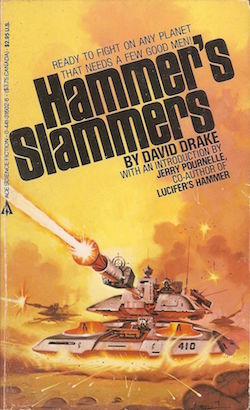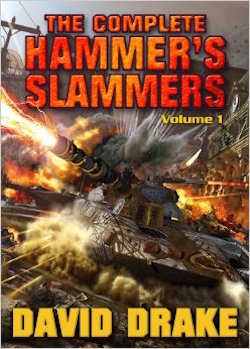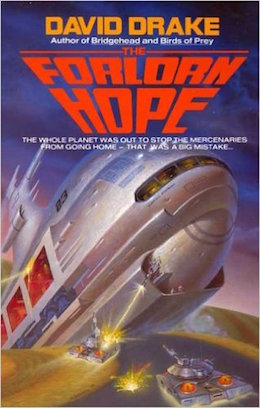In this monthly series reviewing classic science fiction books, Alan Brown will look at the front lines and frontiers of science fiction; books about soldiers and spacers, explorers and adventurers. Stories full of what Shakespeare used to refer to as “alarums and excursions”: battles, chases, clashes, and the stuff of excitement.
The United States is divided by concerns about a stagnant economy and trade imbalances. The nation is still conflicted about a long and inconclusive war. A charismatic and bellicose Republican has replaced the last President, a scholarly and thoughtful Democrat. The new President promises to increase military spending while cutting back on the bureaucracy and balancing the budget at the same time… That’s right, folks, it’s time to travel back to the 1980s, and look at a work of military science fiction from the Reagan Era.
I can’t remember exactly when I bought a copy of Hammer’s Slammers, my first encounter with the work of David Drake. I don’t think that it was a first edition, since I bought it in the early 1980s. It was a time when military SF was becoming more popular, but this book was something unique. It had a profound effect on me, as it was like no SF I had read before: the combat was brutal, the costs high, and the carnage was described in vivid detail. These soldiers were not fighting for country nor glory, but simply for survival, and for those who fought beside them. The book was a “fix-up,” however—a collection of stories primarily drawn from Galaxy magazine, padded out with some essays that explained the settings and technology in the stories. The second book published in the “Hammer-verse,” Cross the Stars, was a full novel, but was a different sort of tale, being a retelling of the Odyssey in an SF setting.
For this review, I have decided to focus on another early Drake novel, The Forlorn Hope. While this novel is not set in the universe of Colonel Hammer and his mercenaries, it takes place in a very similar milieu and is a vigorous and compelling book on its own, capturing many of the themes that weave their way throughout Drake’s work. As Drake said himself about The Forlorn Hope, it too draws on classical sources: “I used Xenophon’s Anabasis–the March Upcountry–as a model for the opening situation but based the remainder of the milieu more on the Thirty Years War.” But it wears those influences lightly, and stands well as its own tale. And for those who are familiar with Hammer’s Slammers, but are unfamiliar with this particular book, The Forlorn Hope serves as a lesser known treasure, a book that any Hammer’s Slammers fan will enjoy.
David Drake was born on 24 September 1945, and studied Latin and history as an undergraduate before going to law school when the draft intervened in his life. He ended up serving in Vietnam and Cambodia as a member of the 11th Armored Cavalry Regiment; his military role took advantage his education, and he worked in intelligence as an interrogator. That did not mean he avoided combat, as he also served as a loader on a tank. He was deeply affected by his experience. He had wanted to write before he went to war, but now he had a mission as well: to show how horrible war could be. As Drake himself has said, his writing was a form of “self therapy.” He had assistance from writers in his local area (Manly Wade Wellman and Karl Edward Wagner), but Drake’s career was helped immeasurably by editor Jim Baen. It was Baen who bought the first Hammer stories for Galaxy, and Baen as an editor at Ace who suggested collecting the stories into Hammer’s Slammers in 1979. When Baen moved on to Tor Books, he brought Drake and The Forlorn Hope along with him—and when he finally started his own company, Baen Books, it was Baen who made future Hammer stories a centerpiece for his catalog.
 The Forlorn Hope was published by Tor Books as a paperback original in 1984, with a vigorous and stylized cover by Alan Guttierez. It told the story of a company of mercenaries led by the battle-hardened Colonel Guido Fasolini. They have been hired to augment Federal troops of the 522nd Garrison Battalion, who are protecting a mining operation from the Republicans, or “Rubes,” as they are called. The Republicans are led by a fanatical religious sect, and their units have chaplains who serve in roles much like the political officers in the old Soviet Army. When Fasolini took the contract, it looked like easy money, but fortunes have turned against the Federals, and in struggling with adversity, they themselves have become fanatical and cruel to their own troops. The Rubes have promised death to any mercenaries hired by the Federals, and what appeared a lucrative deal is now a death trap.
The Forlorn Hope was published by Tor Books as a paperback original in 1984, with a vigorous and stylized cover by Alan Guttierez. It told the story of a company of mercenaries led by the battle-hardened Colonel Guido Fasolini. They have been hired to augment Federal troops of the 522nd Garrison Battalion, who are protecting a mining operation from the Republicans, or “Rubes,” as they are called. The Republicans are led by a fanatical religious sect, and their units have chaplains who serve in roles much like the political officers in the old Soviet Army. When Fasolini took the contract, it looked like easy money, but fortunes have turned against the Federals, and in struggling with adversity, they themselves have become fanatical and cruel to their own troops. The Rubes have promised death to any mercenaries hired by the Federals, and what appeared a lucrative deal is now a death trap.
The only Federal with any sympathy for Fasolini and his company is Lieutenant Albrecht Waldstejn, the 522’s Supply Officer. He comes from a family of questionable loyalty, which explains his lowly position in the army, but he does the job as best he can, trying to maintain his dignity in difficult times. His two subordinates, Privates Hodicky and Quade are cast-offs, reviled by the others in the battalion. The 522nd is a paper tiger, with dispirited troops led by cowardly and ineffective officers. Fasolini’s team is a collection of misfits and malcontents—fierce fighters, but malcontents nonetheless. His “Executive Officer,” Lieutenant Hussein ben Mehdi, is charming and persuasive; useful in negotiations, but amoral and no military leader. The three sergeants are the backbone and tacticians of the unit. Sergeant Roland Jensen is their gunner, and shepherd of the unit’s single artillery piece. Sergeant Johanna Hummel is a fierce and capable combat leader. Sergeant Mboko is quieter, but no less capable. The unit is made up of a variety of difficult characters. Churchie Dwyer and Del Hoybrin, for example, are bootleggers and thieves. Other troopers range from experienced soldiers to new personnel recruited without any skills simply to round out the unit table of organization. There is a space freighter, the Katyn Forest, at the facility waiting to load ore.
The book opens with bombardment of the camp by a Rube spaceship. Dwyer and Hoybrin save their lives but lose their still in the attack. Lt. ben Mehdi uses the attack as an opportunity to corner one of the female troopers, but his attempt to rape her is interrupted by Sergeant Hummel. Sergeant Jensen uses his gun in an unauthorized manner, and is rewarded with a lucky shot that destroys the attacking spaceship. The Katyn Forest is damaged in the attack, and everyone is shaken, as they realize that it is probably the prelude to a Rube assault. Waldstejn stretches the rules to provide a power receptor unit to the Katyn Forest that they can use to travel between power pylons and reach the dockyards of the capitol city, where they can effect permanent repairs. The Republicans radio an offer to the leaders of the 522: if they surrender and swear loyalty to the new religion, they will be given places in the Republican Army. They must simply capture Fasolini’s unit and turn them over to the Republican Army, which means certain death for the mercenaries. Only Waldstejn sees anything wrong with this, and when Fasolini realizes what is happening, he is killed before he can reach his unit.
Waldstejn offers the mercenaries assistance in escaping, and his privates join him. They fight their way out of the camp, but they are a long way from safety. The Republicans overrun the 522nd, and incorporate the unit into their forces. Waldstejn realizes that the Katyn Forest is their only chance of escape, and he and the mercenaries formulate a plan to fight their way back into the camp, now reinforced by Republican tanks. Even after they reach the camp, they will have to fight their way across miles of hostile territory before finding any measure of safety. I will leave my summary there to avoid spoiling any further details of the plot.
The Forlorn Hope is a page-turner, fast-paced and hard to put down. The characters, with the possible exception of Lieutenant Waldstejn, are hardly sympathetic, but compelling and well-realized. The military technology of the Hammer-verse is well thought out, with weapons that fire projectiles in a plasma state, and hovercraft replacing wheeled and tracked vehicles. Notable in The Forlorn Hope is Drake’s description of the use of drones in combat, a technology that was still decades in the future when he wrote the story. The tactics his infantry use against tanks ring true when I compare them with stories my father told of facing Panzers during the Battle of the Bulge. There is a realism and a grittiness to his tales that is lacking in many other military SF books.
 As the 1980s progressed, and beyond that to the present, Drake’s career went from one success to another. The Hammer series expanded to many volumes. Drake has written a number of standalone books, with Roman and classical settings being used in many. He became a noted fantasy author, with the book Lord of the Isles being the first in the long and successful “Isles” fantasy series, and the “Books of the Elements” series beginning with The Legions of Fire. Due to his success, Drake was asked to participate in a number of anthology series, and he co-authored a number of books as well, notably the “Belisarius” series with Eric Flint and the “General” series with S. M. Stirling and others. He is currently working on the “RCN” or “Republic of Cinnabar Navy” series, standalone novels inspired by the Aubrey/Maturin novels of Patrick O’Brian, which feature protagonists Daniel Leary and Adele Mundy. His career has been long and varied, and he has garnered a great deal of respect along the way.
As the 1980s progressed, and beyond that to the present, Drake’s career went from one success to another. The Hammer series expanded to many volumes. Drake has written a number of standalone books, with Roman and classical settings being used in many. He became a noted fantasy author, with the book Lord of the Isles being the first in the long and successful “Isles” fantasy series, and the “Books of the Elements” series beginning with The Legions of Fire. Due to his success, Drake was asked to participate in a number of anthology series, and he co-authored a number of books as well, notably the “Belisarius” series with Eric Flint and the “General” series with S. M. Stirling and others. He is currently working on the “RCN” or “Republic of Cinnabar Navy” series, standalone novels inspired by the Aubrey/Maturin novels of Patrick O’Brian, which feature protagonists Daniel Leary and Adele Mundy. His career has been long and varied, and he has garnered a great deal of respect along the way.
During the 1980s, Drake and other military SF writers generated a great deal of controversy. Those were the days when the Cold War was at its height, and many thought that the saber-rattling of the Reagan Administration would lead to the end of civilization instead of the collapse of the Soviet Union. There were many in the SF community who branded the work of Drake and others as “war porn,” stories intended to thrill and excite readers by glorifying war. I had the opportunity to meet Drake and hear him in panel discussions during this era, and found this interpretation to be far from the truth. Anyone who accused him of glorifying war did not understand his work, nor the intentions of the man himself. Today’s readers might not realize it, but The Forlorn Hope generated some criticism of Drake from his fellow military SF writers when it was initially released. The female characters that we now take for granted in war stories were extremely rare in those days. In The Forlorn Hope, without any explanation or context, Drake portrayed a military where women routinely fought alongside men in all combat roles. He didn’t advocate it, or judge the effectiveness of the practice—he simply presented it as the way things were done. I remember a great deal of discussion of that aspect of the book, and remember being bemused by the fact that writers who could imagine intelligent aliens and travel between stars not being able to accept women doing what men had done in the past.
David Drake has had a long and illustrious career. The Forlorn Hope may not be widely remembered now, but it stands among his best work, and is an excellent distillation of his themes of the bonds between soldiers and the horrors of war. And now, it’s time for me to hear from you: if you have read it, what were your impressions of The Forlorn Hope? What other works by Drake stand among your favorites, and why did you like them?
[Note: This article originally stated that The Forlorn Hope was set in the same universe as the Hammer’s Slammers series. That turned out to be incorrect, and the article has been amended accordingly.]
Alan Brown has been a science fiction fan for five decades, especially science fiction that deals with military matters, exploration and adventure. He is also a retired reserve officer with a background in military history and strategy.










